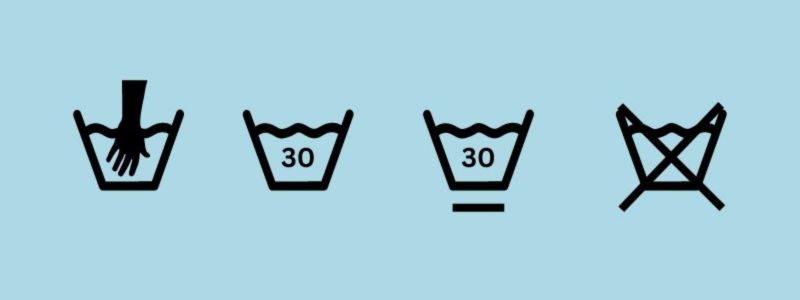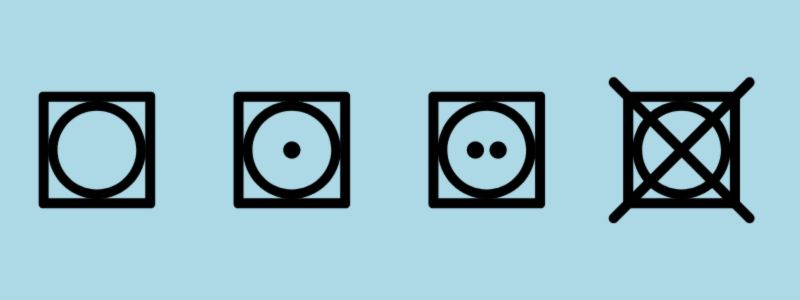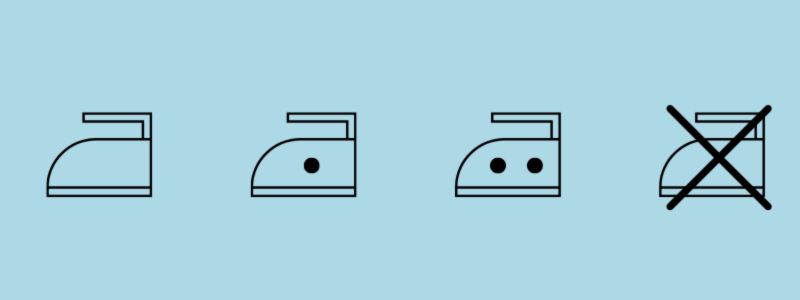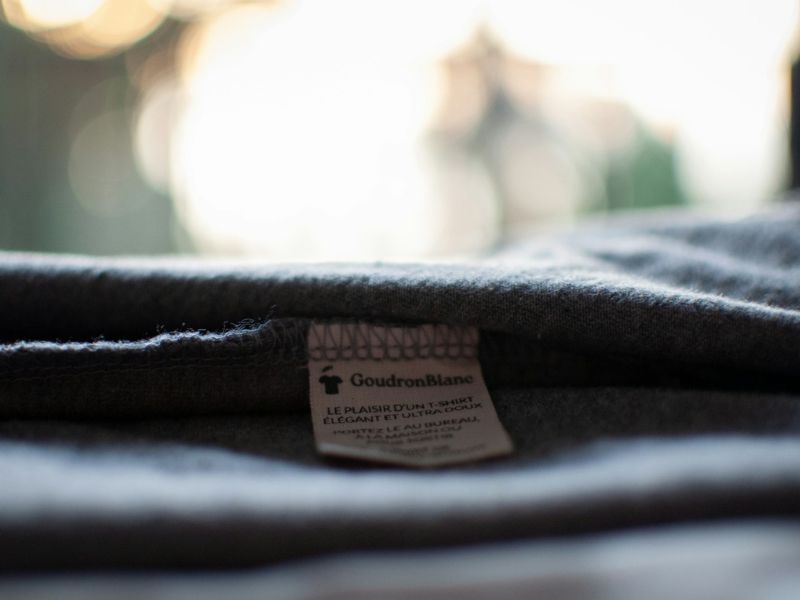How to Read Clothing Labels
Learning how to read clothing labels is a fundamental step towards extending the useful life of your garments.
In the midst of the textile industry's struggle to consolidate less polluting production measures, it is essential to know the characteristics of the clothes we buy.
It is not only a question of opting for the best natural materials to reduce the polluting effects, but also of strengthening consumer habits.
So knowing what the labels on clothes mean helps to keep them in the same quality as on the first day.
While the wide variety of symbols on garments can be a bit overwhelming, they contain instructions on how to wash, dry and iron clothes.
Neglecting this aspect will not only prevent your clothes from lasting much longer in perfect condition, but can also damage them if you don't know how to apply a chemical product that can cause them to deteriorate.
Read this article to the end and discover some great tips on how to take care of your clothes properly, and find out which materials are best for sensitive skin.
CLOTHING LABEL SYMBOL GROUPS
The first step in achieving home laundry care is to read the label, that little black or white piece of information that contains key information for the preservation of the garments.
You will find this label on the back of the garment and it gives specific instructions, which can be more comprehensive if the material used is delicate.
For example, there are some materials that cannot be ironed because they will be damaged instantly.
In total, there are five groups of pictograms that provide information for the maintenance of clothes.
Washing symbols
One of the most important laundry care symbols to consider are those that provide instructions on how to wash clothes.
They may give information about the maximum temperature level allowed for washing clothes or which products are allowed for this process, but of course they will also give out which chemicals should not be used.
Some manufacturers warn about the dangers of washing with bleach and similar chemicals, as although some household methods suggest that they can whiten clothes, the result can be very negative.

- Bucket full of water with one hand
Before carrying out the washing process, it is important to check what the label indicates. If you have noticed the symbol of a bucket full of water with one hand, it is because it can only be washed by hand.
Often, this label also means that the temperature used to wash the clothes should not exceed 30 degrees Celsius.
Some very delicate fabrics and textile fibres, such as wool or silk, must often be washed by hand.
Note: the examples given are approximate and do not apply in 100% of cases, as there are garments made up of more than one material that can be washed in other ways.
- Bucket full of water with number
This symbol means that the garment can be machine washed by hand. But it has the particularity that the number that appears is the indication of the maximum temperature to which you can subject your clothes.
Overlooking this detail can be very detrimental to the care of your garments, especially because it could fade or shrink them. There is no doubt about the importance of how to read clothing labels, appreciating this aspect.
- Bucket full of water with a line underneath
This may be one of the most complicated garment care symbols to understand, but basically what it refers to is that it is a delicate garment that although it can be machine washed requires special washing.
It also refers as part of its garment care instructions that the more lines that are integrated into the symbol the more delicate the garment is. In fact, some choose to hand wash considering all these aspects.
For extra delicate clothes you can choose to set your machine with a programme suitable for this type of garment, and if you don't have this option, taking your clothes to a dry cleaner is a fairly safe alternative.
- Bucket full of water crossed out or a cross over it
It is essential that you know how to read clothing labels when you see symbols as decisive as this one, as it indicates that the garment cannot be washed as contact with water can damage the textile fibre.
The classic examples of this are garments made of leather or certain special synthetic materials. However, when this symbol is displayed, it is essential to persist with the idea of washing, and a dry-cleaning technique can be chosen.
Dry cleaning symbols
Now in the guide on how to read clothing labels we will show you how to interpret the dry cleaning symbols.
Some materials or textile fibres that often need to be dry cleaned are vinyl leather, pure wool or velvet clothes, especially when they are 100% made of these materials.

- Crossed-out circle or with a cross over it
This is one of the most intuitive clothing labels, as it is easy to perceive that these garments cannot be dry-cleaned, due to the cross on the label.
Ignoring these instructions could damage the garment to the point of ending its useful life, or generate aesthetic flaws that affect the quality of the garment.
- Circle
If you notice a circle on the label before you wash your clothes, it means that the garment can be dry cleaned. For those who are experienced in dry cleaning, this condition can be very easy to handle.
But for those who do not know how to dry clean clothes, the option of visiting a dry cleaner or a professional laundry is a good one.
- Circle with an A, P or F in it
This is a key point especially if you have decided to use laundry bleach to combat a stain, because depending on the letter on the instructions you will know the type of solvent with which you can wash the garment.
For example, if the label has a circle and in the middle the letter P, then it is a garment that can be washed using perchloroethylene.
These symbols can also refer to whether the garment can have more or less exposure to the sun, the presence of the letter F symbolises that the garment can be dried in the shade.
Traditional drying symbols
These are four types of very characteristic signs.

- Square with a semicircle on top
If you notice when washing your clothes that the label has a square with a semicircle at the top, it means that the garment can be removed by hanging it on a clothesline.
This is often the case with garments made of much stronger materials such as cotton or certain polyester compositions.
- Square with vertical lines inside it
If you notice this symbol on the label on your clothes, you should choose to air dry them on a hanger, but here the most important thing for fabric care is not to wring them out by hand.
The symbol indicates that you should let it wring out naturally on the hanger. Be careful with that!
- Square with a horizontal line
However, this symbol indicates that the laundry should be dried in a horizontal position. In some cases this is the case for garments with certain prints, as a measure to preserve their appearance as much as possible.
- Square with diagonal lines
Be very careful with the presence of this symbol on your clothes, as the label instruction refers to the fact that the garments should be dried in the shade and direct exposure to the sun could affect them.
As an added bonus, acrylic and polyamide garments often cannot be exposed to direct sunlight as this can damage them.
Symbols for the dryer
When analysing how to read laundry labels, you should not only look at the washing instructions, but the spin maintenance also has some information to take into consideration.
Here are some dryer symbols to check before washing your clothes.

- Square with a circle inside
First of all, this symbol indicates that the clothes can be put into the dryer without any inconvenience.
You must take certain precautions, as some clothes made of leather or fur do not usually have this option as they can become deformed.
- Square with a circle inside it and a dot inside it
If you notice this symbol on the label of your clothes, you should know that you can machine dry them, but on the condition that you set a low temperature. Be careful with that!
- Square with a circle inside it and two dots inside it
This is often a symbol that appears for much stronger and more versatile garments that can be dried at a normal temperature.
Some brands integrate this symbol and incorporate a larger number of dots in the middle, in which case it means that the garment can be dried at a much higher temperature.
- Square with a crossed-out circle or a cross over it
This is the characteristic symbol indicating that a particular laundry cannot be put in the dryer, often in these cases the laundry must be placed in the sun but not in direct sunlight, but in the shade.
Symbols for the ironing of a garment
In the following, we will introduce you to the symbols that give instructions on how to iron clothes. It is essential to pay attention to this kind of information in order not to damage the textile fibre.

- Iron
This is another very intuitive symbol which means that the garment can be ironed without any problems. Although it must always be done at a prudent temperature and with the necessary precautions.
- Iron with a dot inside
If your garment refers to this symbol, it is because it can be ironed but with a low temperature setting. It is very common on garments made of delicate materials such as satin.
- Iron with two points inside
This symbol indicates that the garment can be ironed and that it can even be set to a temperature between medium and slightly higher, here the difference is established by the number of dots, the more dots, the higher the temperature allowed.
- Strikethrough plate
If your garment has this symbol on the label it is because it simply cannot be ironed, it is quite common in some types of wool and skipping this information or ignoring it on a monthly basis can be harmful.
Bleach or bleach symbols
This is another key point on how to read clothing labels, because not all chemicals are suitable for certain garments. Take note!

- Triangle
The presence of a triangle on the label indicates that it can be washed with any bleach or even some kind of bleach, but don't forget to use the right concentration to avoid fading.
- Triangle with diagonal lines
If the label includes a triangle with diagonal lines, the garment can only be washed with bleach, but no other bleaching agents can be used.
- Strikethrough triangle
In case your garment shows a crossed-out triangle on the label, it is because under no circumstances can it be washed with bleach or any other laundry bleaching product.
CONCLUSION AND FINAL TIPS
As can be seen, discovering how to read clothing labels is fundamental for the care of clothing and its preservation over the years.
Although some symbols are quite intuitive and give us a hypothetical reference about their meaning, the ideal is to go deeper into the matter in order to have clear instructions that allow an optimal maintenance of the clothes.
As a final recommendation, if you are not very clear about how to wash a delicate or extra delicate garment, instead of venturing out on your own, you can opt to take it to a laundry and seek some additional advice.










Users Reviews